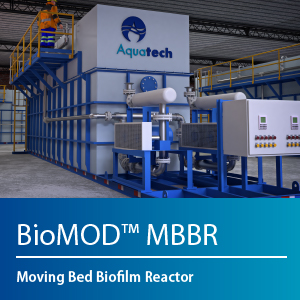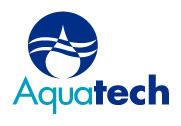Introduction
Aquatech’s BioMOD™ Line of modular biological wastewater treatment systems provides comprehensive, modular solutions to clients from a broad range of industries. Supported by the company’s immense engineering and development experience, the company is deploying BioMOD™ MBBR for a nitrate removal application in the Gulf of Mexico.

Challenge
Industrial and agricultural runoff has worsened the severity of algal blooms and nitrous oxide emissions in North America and beyond. Additionally, groundwaters high in nitrates from these sources can cause life-threatening health conditions if ingested in high quantities. While many novel solutions are being actively implemented (restoring floodplains, seaweed farms, etc..), Biological Nutrient Removal (BNR) from wastewater continues to be a reliable and sustainable strategy for affected facilities and municipalities alike. The issue is prevalent in watersheds throughout the US, and increasingly well-known to the public sphere due to its implications on both human and
ecosystem health. As a result, municipal authorities have started to enact regulations at the state level to encourage point-source BNR. Some facility operations are not large enough to justify a custom site-constructed BNR plant, though. In these cases, a standard modular unit is a financially attractive alternative.
This case study is centered around a client who contracted Aquatech to implement a modular nitrate-removal solution in order to meet new local groundwater discharge norms in a cost-effective way.
Project
An important project of one of our trusted clients was facing discharge challenges on account of regulatory changes and needed to achieve nutrient reduction in order to continue operations. Our client was aware of this development, along with the environmental reasoning for it.
The combined waste emanating from cooling tower operations and associated additives, reverse osmosis (RO) reject, demineralizer regeneration and facility floor drains required a nitrate reduction from 80 to 10 ppm. Typically, nutrient removal includes nitrate and phosphate reduction, however the phosphate was not a driving issue for this discharge compliance.
Solution
A loading rate of Nitrate 100 tons/year was deemed moderately high by industry standards. Aquatech compared the potential solutions with the client and identified our BioMOD™ MBBR as the best technology to meet the client’s expectations (reliability of treatment, cost effectiveness, short turnaround schedule and constructing the unit amidst ongoing plant operations, etc..) due to its compact yet efficient design. Further, using a BioMOD™ meant that the complete BNR process would be completed within modular, standard-freight treatment units. In this case, we were able to easily provide a necessary anoxic zone into the applicable BioMOD™ unit as a modification to the standard product. Even with BioMOD™’s versatility, though, biological water treatment often causes anxiety for industrial
client.
Accordingly, Aquatech completed an engineering study for the client to demonstrate the effectiveness of our underlying MBBR technology and boost the customer’s confidence. The study was conducted by our foremost wastewater treatment experts and featured a mesophilic biological culture, inmixed and unaerated beakers for an allotted time span. The lack of oxygen used in the lab-scale reactors created an anoxic condition that facilitates the removal of nitrates/nitrites by their conversion to nitrogen gas, also known as denitrification. The demonstration went as planned, proving the performance capability of a modified BioMOD™ unit. Our complete treatment scheme has been outlined on the previous page.
After the client assessed this scheme and the CapEx savings it would bring relative to site-constructed solutions (nearly $0.5M), they were keen to proceed on a fast timeline. The decision was also simplified by the BioMOD’s flexibility in accommodating such a high nitrate load in only 2 standard-freight skids. Additional value delivered came in the form of having all process components pre-assembled within a single skid to simplify installation, commissioning and operation. However, the most compelling reason for choosing BioMOD™ was our client’s high comfort level with the Aquatech & level of support provided. Our engineering group has decades of experience and reliability providing and operating high-quality equipment, with minimal asset risk transferred to our clients. In the event that our client changes their plans, BioMOD™ can also be easily replaced or moved to another site unlike a site-constructed BNR system.
Conclusion
To summarize, 2 BIOMOD™ MBBR units were provided for denitrification followed by post-aeration to remove COD, followed by a proprietary Parallel-Plate Clarifier for solids separation and a Volute Press to thicken solids for composting or disposal. The project will be executed in Q3 2021 and demonstrates the biological flexibility of BioMOD™ for BNR applications. Given our planet’s proliferating struggles to maintain biodiversity, all facilities & municipalities with nutrient issues should seriously evaluate BNR with BioMOD™ as a novel way to achieve ESG goals while meeting present or future water regulations.
Keywords
- BNR – Biological Nutrient RemovalBioMOD™ – Aquatech’s line of packaged wastewater treatment solutionsDenitrification – process by which nitrogen- based compounds are reduced to nitrogenAeration – process by which organics can be consumed when appropriate bacteria is introduced. MBBR is an aerobic process.
Algal blooms – Colonies of algae in a body of water which are proliferated by Nitrogen and Phosphorus
Dead zones – Regions of the ocean where marine life cannot exist, usually due to toxins and impaired water quality from algae
Biodiversity – A measure of the health of an ecosystem

